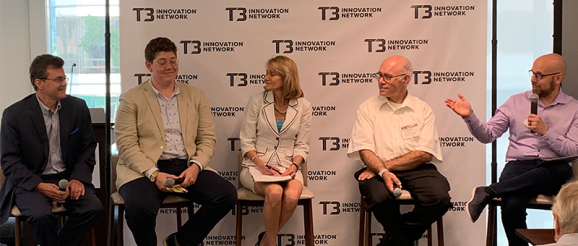The T3 Innovation Network Explores How Data and AI Can Develop a Stronger Workforce

The T3 Innovation Network Explores How Data and AI Can Develop a Stronger Workforce
Current news coverage surrounding workforce issues center mostly on present labor force concerns, with the U.S. possessing 3.4 million fewer workers today than it did in February 2020. On top of this, there are 10.7 million open jobs, but only about 5.7 million unemployed people are looking for positions.
While these remain pressing concerns, artificial intelligence (AI) and the use of technology maintain a strong influence on the labor force and impact the future of work now as more companies seek skills-based workers compared to traditional knowledge-based hiring models.
The U.S. Chamber of Commerce Foundation and the T3 Innovation Network hosted a Mid-Year Meeting on August 4 at the Bill & Melinda Gates Foundation to take a closer look at how data and AI shape our economy and workforce through collective action. The event allowed participants to network and collaborate on a variety of topics, such as the Master Use Case for Skills-Based Hiring and Advancement and implications for the T3 Innovation Network.
During a panel discussion, Naomi Boyer, executive director of digital transformation at Education Design Lab, noted that we must center workers amid developing technology.
“If we are designing for equity, it needs to be for those that are not well resourced,” she said. “We need to use that persona as we think through all of this. It’s not about the technology. It’s about the people we’re serving through that technology and internalizing that as the process of our work becomes really important.”
Workers are struggling in a labor market that is changing rapidly and becoming more dynamic. Even before the pandemic, the U.S. faced an intense skills gap where a current learned skill will be worth about half the value five years from now. This problem will persist and be exacerbated by increasingly developed technology and innovation.
One bright spot for using AI exists in the structured matching of job requirements with the candidates’ skills and competencies. This development can allow employers to find candidates best suited for roles and provide better opportunities for non-traditional talent in the labor market.
Despite credential and hiring potential from AI, the data used for matching skills still lacks accuracy and prevents matching competency frameworks.
Jim Goodell, director of innovation at QIP, also noted advancement continues to present concerns.
“We need to understand that the AI is not going to solve the problems in education and training,” he said. “There are some things that we do as humans that need to change, like focusing more on 21st-century skills rather than knowledge. We need to change attitudes about how we do education and training. We need to make everyone a lifelong learner. Where in the past, we’ve had this mentality that you go through an education system, you get a degree, and then you’re all set to work for the rest of your life. We’re not there anymore.”
While AI continues to become more and more personalized in our everyday use as consumers, such as film and TV show recommendations on Netflix or customer-service chatbots, we still are not tailoring our educational systems.
“In our systems, we have basically created compliant learners that know how to sit and be told what they need to know and be able to do, rather than individuals that know how to cultivate that themselves,” Boyer explained. “As we’re building all of these tools, we need to think about how we build in guardrails to help those that are under-resourced, to help those that don’t have the experiences, because those are the individuals that are disenfranchised from these organizations that will benefit the most and be the personas we need to be programming for as we think about building this strong skills pipeline.”
As AI improves and merges more with workforce development and learning to become more synchronous, workers can adopt new skills as employers learn to articulate their needs, leading to a more complete and innovative American workforce.
Are you an employer looking to create a more equitable workforce through leveraging technology and data? Learn more about the T3 Innovation Network here.

